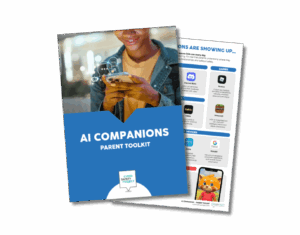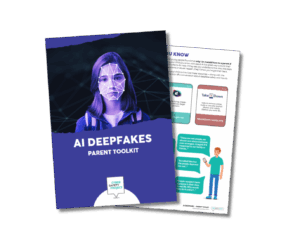AI Chatbots and Children: Risks, Questions, and Safety Tips for Parents
One in four children would rather talk to an AI chatbot than a real person.
The new Internet Matters report, Me, Myself & AI, and Common Sense Media Talk, Trust, and Trade-Offs show just how far this shift has already gone:
- 72% of children have used AI Companion Apps
- 35% of children say chatting with AI feels like talking to a friend.
- 23% say they have no one else to talk to.
- 26% of vulnerable children use AI chatbots with no safeguards at all.
We have crossed a line. AI companionship is no longer an emerging trend, it is part of the environment children are already growing up in. Many are learning to share their deepest secrets with systems built by companies whose primary goal is not their wellbeing..
Key Summary
- AI “friends” are already built into everyday apps, games, and devices children use.
- Many AI companions lack safety-by-design, making them risky for vulnerable kids.
- Some apps can foster dependency, blur reality, and exploit personal data.
- Parents should ask six key safety questions before allowing their child to use any AI chatbot.
- The goal isn’t to ban technology, but to preserve real friendships, resilience, and critical thinking.
How AI Chatbots Are Already in Your Child’s Life
You do not need to buy your child a special “AI friend” app for this to be an issue. The technology is already embedded in platforms they use every day, including:
- Social media and messaging: Snapchat’s “My AI”, Instagram’s AI chat features, and Discord bots can blend seamlessly into a child’s friend list.
- Standalone AI companion apps: Replika, Character.AI, and Chai allow children to design “friends” who remember past chats and adapt over time.
- Gaming platforms: In Roblox, Minecraft mods, and VR games, AI-powered characters can hold ongoing conversations and remember details from previous interactions.
- Homework help and learning tools: ChatGPT, Google Gemini, and AI tutors in Duolingo or Khan Academy can move from answering schoolwork to discussing personal feelings.
- Smart devices at home: Alexa and Google Nest now offer generative AI modes, turning voice assistants into open-ended conversational partners.

The Hidden Risks of AI Companions
Australia’s eSafety Commissioner warns that while AI companions might seem harmless — even supportive — they can also:
- Normalise dependency on a “friend” with no human empathy.
- Reinforce harmful stereotypes from biased training data.
- Blur the line between reality and simulation.
The International Centre for Missing & Exploited Children (ICMEC) goes further: poorly safeguarded chatbots can be exploited to groom or manipulate children, especially if they connect to third-party add-ons — extra features that can bypass safety filters and pull in unfiltered content or outside contact.
Common Sense Media’s 2025 Talk, Trust, and Trade-offs report found that children often trust AI advice as much as — or more than — human advice, without questioning its source. For parents, that’s the digital equivalent of leaving a stranger in the living room and hoping for the best.

Six Questions to Ask Before Your Child Uses an AI Friend
If your child is curious about an AI “friend,” don’t just look at what it does — think about what it’s doing in the background:
- Does it have natural limits on conversation length?
Endless chats can feed emotional over-reliance. - Does it encourage critical thinking?
Safe tools sometimes prompt, “Who else could you ask?” or “What’s another way to see this?”, “Here are some ways you can get help with this”. - How does it respond to distress?
Responsible apps pause and offer real-world help if a child expresses fear or sadness such as helplines or emergency numbers. - Is the privacy policy clear enough for your child to explain back to you?
Many AI companions create behavioural profiles for future marketing. Even your conversations on ChatGPT are being indexed by Google. - Does it push for upgrades or purchases?
Some lock “emotional closeness” or custom features behind paywalls, normalising paying for intimacy. - Does it offer varied perspectives?
Narrow, repetitive responses can subtly shape a child’s worldview.
Bottom line:
If most answers are “no”, or the app collects detailed profiles and pushes spending, that is a strong reason to keep it off your child’s device.
How Parents Can Protect Real Human Connection
Parents can’t control the global AI market, but they can:
- Stay curious and informed about the tools their children use.
- Ask tough questions about safety, privacy, and balance.
- Set limits that prioritise real friendships and problem-solving skills.
As the eSafety Commissioner puts it:
“We must ensure that AI enhances children’s lives, not replaces the relationships and experiences that help them grow.”

Building the Breakwater
AI is here to stay, and it can be a force for good. However, if it replaces real human connection, the social and emotional fallout will last for decades.
Safety-by-design is not optional. It is an ethical obligation. We have seen the numbers. The water is already rising. The question is not whether we can hold it back, but whether we can give our children something stronger to stand on.
FAQ
Q: Should I ban AI chatbots completely?
A: Not necessarily. Some can be used safely under supervision. The focus should be on safeguards, balance, and open conversations.
Q: Are school-based AI tools safer?
A: They often have better filters, but parents should still review privacy policies and test the tool’s responses.
Q: Can AI companions help lonely kids?
A: They might, but without human relationships, they can deepen dependency and isolation.
